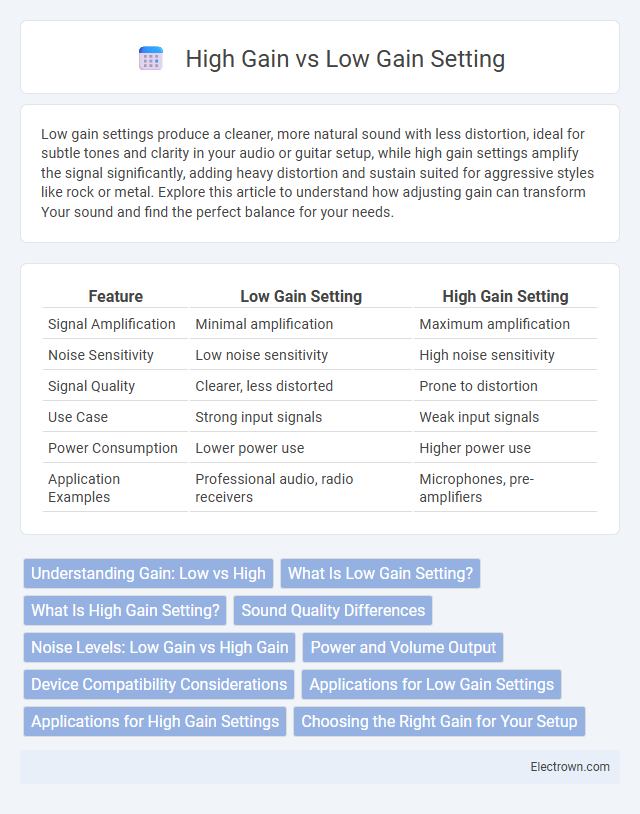Low gain settings produce a cleaner, more natural sound with less distortion, ideal for subtle tones and clarity in your audio or guitar setup, while high gain settings amplify the signal significantly, adding heavy distortion and sustain suited for aggressive styles like rock or metal. Explore this article to understand how adjusting gain can transform Your sound and find the perfect balance for your needs.
Table of Comparison
| Feature | Low Gain Setting | High Gain Setting |
|---|---|---|
| Signal Amplification | Minimal amplification | Maximum amplification |
| Noise Sensitivity | Low noise sensitivity | High noise sensitivity |
| Signal Quality | Clearer, less distorted | Prone to distortion |
| Use Case | Strong input signals | Weak input signals |
| Power Consumption | Lower power use | Higher power use |
| Application Examples | Professional audio, radio receivers | Microphones, pre-amplifiers |
Understanding Gain: Low vs High
Low gain settings provide cleaner sound with less distortion, ideal for preserving your instrument's natural tone at lower volumes. High gain settings increase amplification, producing more distortion and sustain, commonly used in genres like metal and hard rock for a heavier sound. Adjusting your gain control helps balance clarity and intensity, allowing you to shape your tone to fit your musical style and environment.
What Is Low Gain Setting?
A low gain setting refers to an amplifier configuration that produces minimal signal amplification, resulting in a cleaner and quieter output with less distortion. It is ideal for achieving natural sound quality and preserving the original tone, especially in guitar amplifiers and audio equipment. Low gain settings help maintain clarity and dynamics, making them suitable for genres requiring a crisp, unaltered sound profile.
What Is High Gain Setting?
High gain settings amplify an audio signal more intensely, increasing volume and distortion to enhance sound details in loud environments. This setting is ideal for genres like rock or metal, where aggressive tones and saturation are desired. You can adjust high gain to achieve powerful, crunchy riffs while maintaining clarity in your audio output.
Sound Quality Differences
Low gain settings produce cleaner, more transparent sound with minimal distortion, preserving the instrument's natural tone and dynamics. High gain settings increase signal amplification, resulting in pronounced distortion, sustain, and harmonic richness, which are favored in genres like metal and hard rock. The choice between low and high gain directly impacts sound clarity and texture, with low gain offering crispness and high gain delivering aggressive, saturated tones.
Noise Levels: Low Gain vs High Gain
Low gain settings typically produce lower noise levels, resulting in cleaner audio signals with less background hiss, making them ideal for capturing subtle sound details. High gain settings amplify the input signal, which increases both the desired audio and unwanted noise, potentially introducing more hiss and distortion. Adjusting your device's gain properly balances signal strength and noise, ensuring optimal sound quality for your recording or amplification needs.
Power and Volume Output
Low gain settings produce lower power amplification, resulting in quieter volume output ideal for clean tones and minimal distortion. High gain settings significantly increase power output, driving your amplifier harder to achieve louder volume levels and saturated, distorted sounds. Adjusting gain affects your amp's loudness and tonal character, helping you control your sound's power and volume to suit different playing environments.
Device Compatibility Considerations
Low gain settings are compatible with a wide range of devices, particularly those with sensitive microphones or preamps, preventing distortion and maintaining audio clarity. High gain settings may require more advanced or professional-grade equipment to handle increased signal strength without introducing noise or clipping. Your choice between low and high gain should consider the specific device's input sensitivity and intended recording environment for optimal performance.
Applications for Low Gain Settings
Low gain settings are ideal for applications requiring minimal signal amplification, such as recording quiet acoustic instruments or capturing subtle vocal nuances in studio environments. These settings reduce noise and distortion, preserving audio clarity and dynamic range when dealing with naturally strong sound sources. Low gain is also preferred in field recordings where environmental sounds need to be accurately represented without added electronic interference.
Applications for High Gain Settings
High gain settings are essential for applications requiring enhanced signal sensitivity and increased amplification, such as in wireless communication, audio equipment, and scientific instrumentation. These settings enable your devices to detect weaker signals, improving performance in noisy or distant signal environments. High gain is particularly beneficial for long-range transmissions, sensitive sensors, and high-quality sound systems where clarity and strength are crucial.
Choosing the Right Gain for Your Setup
Selecting the appropriate gain setting depends on your audio equipment and environment, with low gain preferred for clean, noise-free signals and high gain suited for boosting weak inputs. Low gain minimizes distortion and background noise, ideal for loud sound sources or close microphones. High gain amplifies quiet signals but requires careful adjustment to avoid clipping and maintain sound clarity in recordings or live setups.
low gain vs high gain setting Infographic

 electrown.com
electrown.com